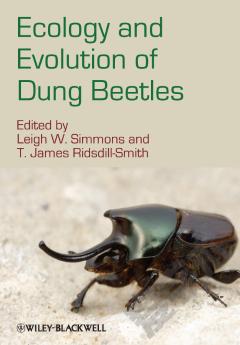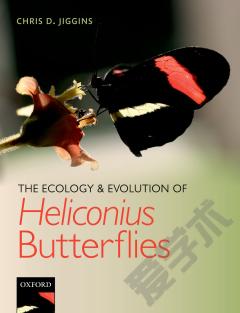Ecology and Evolution of Dung Beetles
List of Contributors. Preface. 1. Reproductive competition and its impact on the evolution and ecology of dung beetles (Leigh W. Simmons and T. James Ridsdill-Smith). 1.1 Introduction. 1.2 Competition for mates and the evolution of morphological diversity. 1.3 Competition for resources and the evolution of breeding strategies. 1.4 Ecological consequences of intraspecific and interspecific competition. 1.5 Conservation. 1.6 Concluding remarks. 2. The evolutionary history and diversification of dung beetles (T. Keith Philips). 2.1 Introduction. 2.2 Scarabaeinae diversity and tribal classification issues. 2.3 Scarabaeine dung beetle phylogenies. 2.4 The sister clade to the Scarabaeinae. 2.5 The origin of the dung beetles. 2.6 The oldest lineages and their geographic origin. 2.7 Evolution of activity period. 2.8 The evolution of feeding habits. 2.9 Evolution of derived alternative lifestyles. 2.10 Evolution of nidification: dung manipulation strategies. 2.11 Evolution of nidification: nesting behaviour and subsocial care. 2.12 Conclusions. 2.13 Future work / gaps in knowledge. 3. Male contest competition and the evolution of weapons (Robert Knell). 3.1 Introduction. 3.2 Dung beetle horns as weapons. 3.3 Functional morphology of horns. 3.4 Horns as predictors of victory. 3.5 Are beetle horns simply tools? 3.6 The evolution of horns: rollers vs. tunnellers. 3.7 The evolution of horns: population density. 3.8 The evolution of horns: sex ratio. 3.9 Future work. 4. Sexual selection after mating: the evolutionary consequences of sperm competition and cryptic female choice in onthophagines (Leigh W. Simmons). 4.1 Introduction. 4.2 Sperm competition theorey. 4.3 Evolution of ejaculate expenditure in the genus Onthophagus. 4.4 Evolutionary consequences of variation in ejaculate expenditure. 4.5 Theoretical models of female choice. 4.6 Quantitative genetics of ejaculate traits. 4.7 Empirical evidence for adaptive cryptic female choice in Onthophagus Taurus. 4.8 Conclusions and future directions. 5. Olfactory ecology (G. D. Tribe and B. V. Burger). 5.1 Introduction. 5.2 Orientation to dung and other resources. 5.3 Olfactory cues used in mate attraction and mate recognition. 5.4 Chemical composition of Kheper pheromones. 5.5 Kairomones. 5.6 Defensive secretions. 5.7 Conclusions and future directions. 6. Explaining phenotypic diversity: The conditional strategy and threshold trait expression (Joseph L. Tomkins and Wade Hazel). 6.1 Introduction. 6.2 The environmental threshold model. 6.3 Applying the threshold model. 6.4 Future directions. 7. Evolution and development: Onthophagus beetles and the evolutionary development genetics of innovation, allometry, and plasticity (Armin Moczek). 7.1 Introduction. 7.2 Evo-devo and eco-devo A brief introduction. 7.3 Onthophagus beetles as an emerging model system in evo-devo and eco-devo. 7.4 The origin and diversification of novel traits. 7.5 The regulation and evolution of scaling. 7.6 The development, evolution, and consequences of phenotypic plasticity. 7.7Conclusion. 8. The evolution of parental care in the onthophagine dung beetles (John Hunt and Clarissa House). 8.1 Introduction. 8.2 Parental care theorey. 8.3 Testing parental care theorey using onthophagine dung beetles. 8.4 Conclusions and future directions. 9. The visual ecology of dung beetles (Marcus Byrne and Marie Dacke). 9.1 Introduction. 9.2 Insect eye structure. 9.3 Eye limitations. 9.4 Dung beetle vision. 9.5 Visual ecology of flight activity. 9.6 Sexual selection and eyes. 9.7 Ball rolling. 9.8 Conclusions. 10. The ecological implications of physiological diversity in dung beetles (Steven L. Chown and C. Jaco Klok). 10.1 Introduction. 10.2Thermoregulation. 10.3 Thermal tolerance. 10.4 Water balance. 10.5 Gas exchange and metabolic rate. 10.6 Conclusion and prospectus. 11. Dung beetle populations: structure and consequences (Tomas Roslin and Heidi Viljanen). 11.1Introduction. 11.2 Study systems. 11.3 Range size. 11.4 Habitat and resource selection. 11.5 Dung beetle movement. 11.6 The genetic structure of dung beetle populations. 11.7 Consequences: spatial population structures and responses to habitat loss. 11.8 Perspectives. Biological control: ecosystem functions provided by dung beetles (T. James Ridsdill-Smith and Penny B. Edwards). 12.1 Introduction. 12.2 Function of dung beetles in ecosystems. 12.3 Dung beetles in pasture habitats. 12.4 Seasonal occurrence and abundance of native dung beetles in Australia. 12.5 Distribution and seasonal occurrence of introduced dung beetles in Australia. 12.6 Long term studies of establishment and abundance. 12.7 Competitive exclusion. 12.8 Optimising the benefits of biological control. 13. Dung beetles as a candidate study taxon in applied biodiversity conservation research (Elizabeth S. Nichols and Toby A. Gardner). 13.1 Introduction. 13.2 Satisfying data needs to inform conservation practice. 13.3 The role of dung beetles in applied biodiversity research in human-modified landscapes. 13.4 Dung beetle conservation. 13.5 Some ways forward. References. Index.
{{comment.content}}








 京公网安备 11010802027623号
京公网安备 11010802027623号